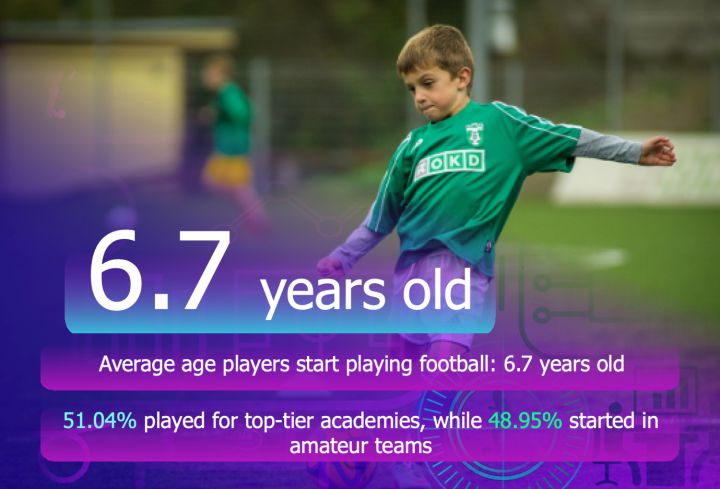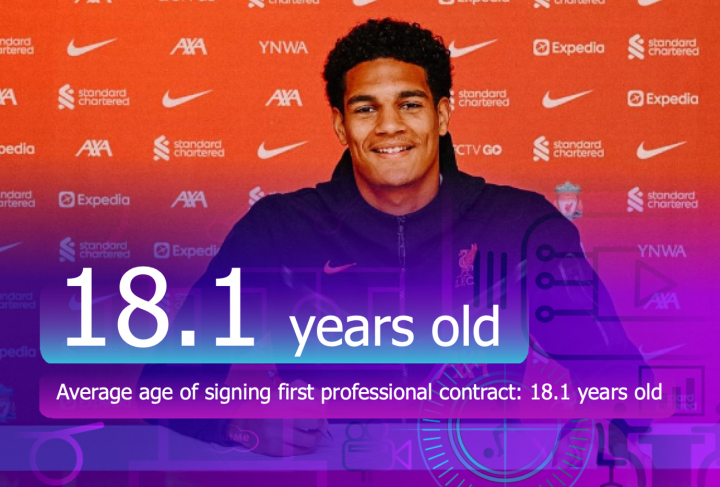
Unlocking the Premier League dream: unveiling the path from grassroots to glory.
The allure of the Premier League beckons like a siren song for countless young footballers. Yet, the road from kicking a ball in the park to gracing the hallowed turf remains shrouded in a certain mystique. Thankfully, groundbreaking research conducted by Scout Me Online sheds light on this intricate pathway, offering aspiring talents a roadmap to success.
In our pursuit to decode the journey to Premier League success, Scout Me Online embarked on a mission to dissect the age progression of current Premier League players from grassroots to their current clubs during the 2023-24 season.
Our aim? To delineate a clear pathway for aspiring youth players, unveiling the trends that delineate the route to becoming a Premier League footballer.
The Missing Puzzle Pieces: Deliberate Practice and Networking
While the mantra of hard work echoes loudly, our findings underscore the importance of nuanced factors often overlooked in mainstream discourse. Delving into the realm of deliberate practice, we confront the elusive question of how many hours are requisite for mastery. Echoing Malcolm Gladwell's seminal work on outliers, we recognize the notion of 10,000 hours as a threshold for expertise, shedding light on the relentless dedication required for success.
Moreover, our research unveils another crucial dimension: the power of networks and connections. With over 50% of players commencing their journey in top-tier academies, the influence of familial or social connections becomes apparent. In alignment with Gladwell's insights, we recognize the significance of "who you know," shedding light on the intricate interplay between opportunity and affiliation.
Our observations reveal a symbiotic relationship between opportunity and connection, where young players are often unearthed in the unlikeliest of places. From the school grounds to the pitch, the influence of educators moonlighting as coaches or possessing connections within the footballing fraternity cannot be understated.
Moreover, our research underscores the significance of geographical advantage in player discovery. Within our network, we've witnessed firsthand the serendipitous encounters on the pitch, where the level of competition and the geographical location serve as fertile ground for talent identification. Whether through chance encounters with opponent teams or the discerning eye of referees with pertinent connections, the journey to Premier League prominence often begins on the grassroots fields of local leagues.

From budding talent to academy player: a nurturing ground.
Our research reveals that the journey often begins remarkably early, with the average player starting their footballing adventure at a tender 6.7 years old. Interestingly, the data suggests a near-even split between those who kickstarted their careers at prestigious academies (51.04%) and those who honed their skills in local teams (48.95%). This highlights a crucial message: flourishing talent can blossom anywhere, not solely within the confines of elite structures.

Academy years: where potential is shaped.
For many, transitioning to a top-tier academy signifies a pivotal moment. The average age of entry into these esteemed institutions sits at 10.3 years old. These formative years spent within a rigorous training environment are crucial, shaping young players into well-rounded professionals. On average, players dedicate 4.9 years to honing their craft within these elite academies (some players joined the academies from the age range between 12-15 years old). This period culminates, at roughly 18.15 years old, with the signing of the first professional contract - a testament to years of relentless dedication.


The professional landscape: a journey of resilience and adaptation.
The path to Premier League stardom rarely follows a straight line. Our research indicates that the average player has donned the jerseys of 3.1 different clubs before securing their coveted spot in the top tier. This period, spanning an average of 8.6 years, underscores the importance of versatility and adaptability. Youngsters must navigate diverse playing styles and environments, constantly evolving their skillset to thrive in the ever-demanding professional game.

Loan spells and international exposure: steppingstones to success.
Loan spells emerge as a strategic tool for gaining valuable playing time and exposure. On average, players undertake loan spells at 1.15 different clubs before securing a permanent spot in a Premier League club, lasting roughly 8.9 months per loan. This practical experience proves invaluable in preparing them for the rigors of the Premier League. Interestingly, the research also highlights the increasingly globalized nature of the sport. Players hailing from various leagues worldwide contribute their unique skillsets, enriching the Premier League with a diverse tapestry of talent.

Birth months and the power of perseverance.
Delving deeper, the research unveils intriguing trends regarding player demographics. Notably, January emerges as the most common birth month (12.22%), followed closely by May (10.71%). The decision to analyze this statistic refers to various university studies imprinted on how a player's birth affects his or her performance. Research like “The relative age effect in youth soccer across Europe” (Helsen W. F., 2004) suggests a possible advantage for young athletes born in the first half of the year, particularly those born in winter months. This "relative age effect" (RAE) stems from two key factors: selection bias, where coaches often favor physically larger players, and a slight physical maturity edge due to natural growth patterns. However, this early lead doesn't necessarily translate to superior athletic or mental capabilities in the long run. While some argue that these players benefit from having more time for training before school starts in countries with a September start date, this advantage is likely minimal. Ultimately, factors like talent, dedication, access to quality coaching, and individual growth patterns play a much larger role in shaping an athlete's success.

Empowering the Next Generation: A Brighter Future.
Within the research, there was a question of who the player used to play for and what league (tier) were they participating in. It’s interesting to see the journey for some of the players and to see the likelihood of a player to follow. This path, paved with unwavering resilience, adaptability, and a burning desire to succeed, serves as a source of inspiration for aspiring footballers. There are players like Max Kilman from Wolverhampton FC came from National League team (tier 5) Maidenhead United FC and another player Ryan Yates from Nottingham Forest came from Scunthorpe United FC (tier 6) shows some possibilities to reach premier league but the reality of best chance is starting at a top tier academy from a younger age. Armed with these insights, young talents can embark on their quest with greater clarity and purpose, one step closer to realizing their dreams on the grandest stage.
Who is Scout Me Online?
Scout Me Online is an online platform where players join for free to get scouted faster. A team of scout analyst watch full match videos of each player (up to 5 games) to assess how good is the player with data and video analysis.
It’s £25 per game to get analysed but for a package of 5 games, you can get it at a reduce price for only £100. An investment to help you get noticed faster!
Scout Me Online have their own software to code up to 542 points of data, using intelligent heat map and breaking down all success and failed action to decide if they will want to promote the player or give feedback with clarity and certainty where player needs to improve before returning back.
Scout Me Online mission is to scout players faster and promote the players to clients with best data and video analysis. Scout Me Online is not an agent but can recommend agents.
For more information, visit www.ScoutMeOnline.com and also follow them on Instagram to keep track of their progress.
Drop a comment below for sharing your own observation or any agreement / disagreement.
Which league should we research on next? Leave a comment and please share this to any parents or football players who would benefit with these information.











Comments